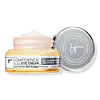What's inside
What's inside
 Key Ingredients
Key Ingredients

 Benefits
Benefits

 Concerns
Concerns

No concerns
 Ingredients Side-by-side
Ingredients Side-by-side

Water
Skin ConditioningPropanediol
SolventPhytonadione Epoxide
AstringentCoco-Caprylate/Caprate
EmollientSodium Acrylates Copolymer
Caffeine
Skin ConditioningLactobacillus Ferment Lysate
Skin ConditioningCamellia Sinensis Leaf Extract
AntimicrobialRuscus Aculeatus Root Extract
AstringentSolidago Virgaurea Extract
Skin ConditioningCitrus Limon Peel Extract
EmollientPunica Granatum Extract
AstringentGlycerin
HumectantOlive Oil Polyglyceryl-6 Esters
EmollientLecithin
EmollientSodium Acrylates Crosspolymer-2
AbsorbentSodium Benzoate
MaskingPotassium Sorbate
PreservativeLauryl Glucoside
CleansingWater, Propanediol, Phytonadione Epoxide, Coco-Caprylate/Caprate, Sodium Acrylates Copolymer, Caffeine, Lactobacillus Ferment Lysate, Camellia Sinensis Leaf Extract, Ruscus Aculeatus Root Extract, Solidago Virgaurea Extract, Citrus Limon Peel Extract, Punica Granatum Extract, Glycerin, Olive Oil Polyglyceryl-6 Esters, Lecithin, Sodium Acrylates Crosspolymer-2, Sodium Benzoate, Potassium Sorbate, Lauryl Glucoside
Water
Skin ConditioningTheobroma Cacao Seed Butter
EmollientGlycerin
HumectantDimethicone
EmollientIsohexadecane
EmollientPropanediol
SolventGlyceryl Stearate
EmollientPEG-20 Stearate
EmulsifyingNiacinamide
SmoothingPEG/PPG/Polybutylene Glycol-8/5/3 Glycerin
HumectantHydroxyproline
Skin ConditioningHydrolyzed Soy Protein
HumectantStearic Acid
CleansingPEG-100 Stearate
Palmitic Acid
EmollientGlycine
BufferingOctyldodecanol
EmollientPolyacrylamide
Silica Silylate
EmollientButylene Glycol
HumectantPhenoxyethanol
PreservativeCaffeine
Skin ConditioningC13-14 Isoparaffin
EmollientPentylene Glycol
Skin ConditioningCI 77891
Cosmetic ColorantTocopherol
AntioxidantHydrolyzed Rice Protein
Skin ConditioningCaprylyl Glycol
EmollientCarbomer
Emulsion StabilisingMica
Cosmetic ColorantLaureth-7
EmulsifyingPanax Ginseng Root Extract
EmollientSodium Hyaluronate
HumectantProline
Skin ConditioningAlanine
MaskingCapryloyl Salicylic Acid
ExfoliatingTrisodium Ethylenediamine Disuccinate
Myristic Acid
CleansingPentaerythrityl Tetra-Di-T-Butyl Hydroxyhydrocinnamate
AntioxidantCeramide NP
Skin ConditioningAdenosine
Skin ConditioningSodium Lactate
BufferingHydroxypalmitoyl Sphinganine
Skin ConditioningPolysorbate 20
EmulsifyingSodium Hydroxide
BufferingCI 77491
Cosmetic ColorantTin Oxide
AbrasivePalmitoyl Tripeptide-1
Skin ConditioningPalmitoyl Tetrapeptide-7
Skin ConditioningWater, Theobroma Cacao Seed Butter, Glycerin, Dimethicone, Isohexadecane, Propanediol, Glyceryl Stearate, PEG-20 Stearate, Niacinamide, PEG/PPG/Polybutylene Glycol-8/5/3 Glycerin, Hydroxyproline, Hydrolyzed Soy Protein, Stearic Acid, PEG-100 Stearate, Palmitic Acid, Glycine, Octyldodecanol, Polyacrylamide, Silica Silylate, Butylene Glycol, Phenoxyethanol, Caffeine, C13-14 Isoparaffin, Pentylene Glycol, CI 77891, Tocopherol, Hydrolyzed Rice Protein, Caprylyl Glycol, Carbomer, Mica, Laureth-7, Panax Ginseng Root Extract, Sodium Hyaluronate, Proline, Alanine, Capryloyl Salicylic Acid, Trisodium Ethylenediamine Disuccinate, Myristic Acid, Pentaerythrityl Tetra-Di-T-Butyl Hydroxyhydrocinnamate, Ceramide NP, Adenosine, Sodium Lactate, Hydroxypalmitoyl Sphinganine, Polysorbate 20, Sodium Hydroxide, CI 77491, Tin Oxide, Palmitoyl Tripeptide-1, Palmitoyl Tetrapeptide-7
 Reviews
Reviews

Ingredients Explained
These ingredients are found in both products.
Ingredients higher up in an ingredient list are typically present in a larger amount.
Caffeine is most associated with coffee, tea, and cacao. In skincare, it helps with calming inflammation and is rich in antioxidants.
While caffeine is used to treat cellulite and and dark circles, further studies are needed to prove this. It has been believed to help with these skin conditions due to its ability to dilate blood vessels and increase blood flow.
Some studies are looking into caffeine's ability to protect against UV rays.
Learn more about CaffeineGlycerin is already naturally found in your skin. It helps moisturize and protect your skin.
A study from 2016 found glycerin to be more effective as a humectant than AHAs and hyaluronic acid.
As a humectant, it helps the skin stay hydrated by pulling moisture to your skin. The low molecular weight of glycerin allows it to pull moisture into the deeper layers of your skin.
Hydrated skin improves your skin barrier; Your skin barrier helps protect against irritants and bacteria.
Glycerin has also been found to have antimicrobial and antiviral properties. Due to these properties, glycerin is often used in wound and burn treatments.
In cosmetics, glycerin is usually derived from plants such as soybean or palm. However, it can also be sourced from animals, such as tallow or animal fat.
This ingredient is organic, colorless, odorless, and non-toxic.
Glycerin is the name for this ingredient in American English. British English uses Glycerol/Glycerine.
Learn more about GlycerinPropanediol is an all-star ingredient. It softens, hydrates, and smooths the skin.
It’s often used to:
Propanediol is not likely to cause sensitivity and considered safe to use. It is derived from corn or petroleum with a clear color and no scent.
Learn more about PropanediolWater. It's the most common cosmetic ingredient of all. You'll usually see it at the top of ingredient lists, meaning that it makes up the largest part of the product.
So why is it so popular? Water most often acts as a solvent - this means that it helps dissolve other ingredients into the formulation.
You'll also recognize water as that liquid we all need to stay alive. If you see this, drink a glass of water. Stay hydrated!
Learn more about Water